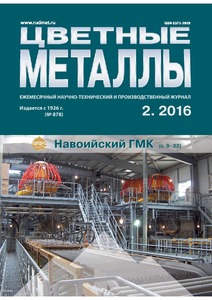Показать сокращенную информацию
Reinforcing base metals for the production of non-heat-treatable composite aluminium-based alloys
| Автор | Babkin, V. G. | |
| Автор | Terentev, N. A. | |
| Автор | Chubarova, N. E. | |
| Дата внесения | 2016-11-11T08:49:15Z | |
| Дата, когда ресурс стал доступен | 2016-11-11T08:49:15Z | |
| Дата публикации | 2016-01 | |
| Библиографическое описание | Babkin, V. G. Reinforcing base metals for the production of non-heat-treatable composite aluminium-based alloys [Текст] / V. G. Babkin, N. A. Terentev, N. E. Chubarova // Tsvetnye Metally. — 2016. — Volume 2016 (issue 2). — С. 85-91 | |
| ISSN | 03722929 | |
| URI (для ссылок/цитирований) | https://elib.sfu-kras.ru/handle/2311/27834 | |
| Аннотация | This paper considers the peculiarities of the production technology of reinforcing base metals Al - Ti(Zr) - C, Al - B - C and possibilities of their application for hardening of commercial-purity aluminium A6 and wrought alloys AD 31 (A-31). Technical aluminium (purity is not less than 99.6% (wt.)) was used as metallic basis for base metal obtaining. Thermostable nano - and microdimensional particles TiC, ZrC, C2Al3B48 (almost insoluble with standard melting and casting temperatures) were synthesized in this aluminium at the temperature of 1000-1100 °C. For the purpose of estimation of crystallization rate on reinforcing base metal structure, the melt was poured into steel and copper water cooling form, and into water during granulated base metal obtaining. Chemical and phase composition of base metals and microstructure of cast samples were investigated. Structure of all base metals includes three phases: aluminium solid solution (Alα); nano- and microdimensional particles ZrC, TiC, C2Al3B48, regularly distributed in metallic matrix; titanium, zirconium and boron aluminides with needle-shaped or lamellar morphology. New composite alloys on the basis of aluminium and wrought alloy Al - Mg - Si were obtained with application of developed reinforcing base metals. There was found the influence of structure, cooling rate and alloy crystallization interval on microstructure and physical-mechanical properties of composite material. Increase of alloy cooling rate from 10 to 100 °C/s leads to crushing of structural components of base metal by 5-10 times. Thermal analysis data tell that alloy crystallization interval is decreased in the following range: (Al - Ti - C) → (Al - B - C) → (Al - Zr - C). Grain size is decreased in the same sequence, and alloy durability is increased. | |
| Ссылка на другой сайт | https://www.scopus.com/record/display.uri?eid=2-s2.0-84960845667&origin=inward&txGid=DBBD574AECCB6AE610E285F569BCABE7.wsnAw8kcdt | |
| Тема | Aluminium alloys | |
| Тема | Base metal | |
| Тема | Composite material | |
| Тема | Cooling rate | |
| Тема | Crystallization interval | |
| Тема | Matrix melt | |
| Тема | Reinforcing particle | |
| Тема | Synthesis | |
| Название | Reinforcing base metals for the production of non-heat-treatable composite aluminium-based alloys | |
| Тип | Journal Article | |
| Тип | Published Journal Article | |
| Страницы | 85-91 | |
| ГРНТИ | 53.49.15 | |
| Дата обновления | 2016-11-11T08:49:15Z | |
| DOI | 10.17580/tsm.2016.02.14 | |
| Институт | Политехнический институт | |
| Подразделение | Кафедра материаловедения и технологии обработки материалов | |
| Журнал | Tsvetnye Metally | |
| Квартиль журнала в Scopus | Q3 |

